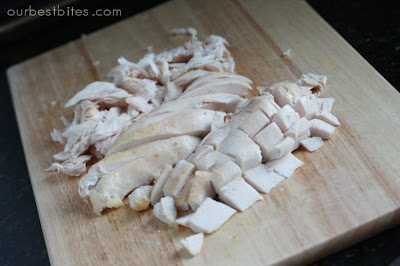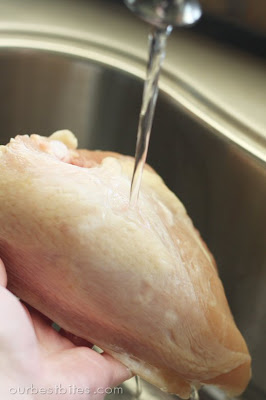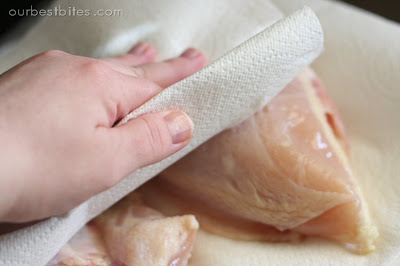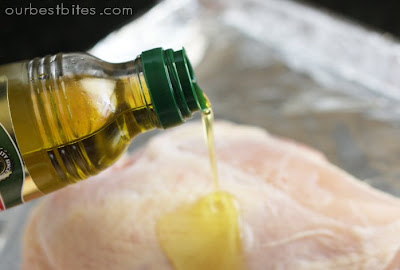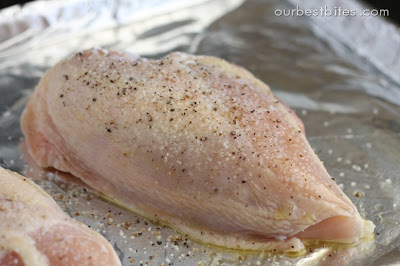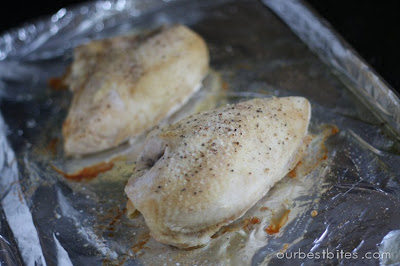I’m going to cover the major methods of cooking a chicken breast. And because I’m living like a hobo right now (tonight, my kids ate spaghetti from paper bowls with plastic spoons on a towel that was on the floor because we’re squarely stuck between two houses), the lovely Sara was gracious enough to take the pictures for today’s post. But first, regardless of your method, there are a few chicken basics:
- Defrosting. If you’re using frozen chicken, it’s best to defrost it first. If you’re really on top of it, you can defrost it a few days ahead of time in the refrigerator. I can guarantee you 100% that I am never that on top of things. This leaves the microwave defrost setting or placing it in a Ziploc bag in cool water, changing the water regularly. I prefer the cool water method because I almost always end up accidentally cooking at least part of the chicken in the microwave and unseasoned, microwaved chicken is not good.
- Rinse the chicken breast in cool water. Especially if you’re buying it non-frozen. Especially if it’s non-frozen with skin and bones. Even if your chicken is well before its expiration date, those liquids it’s sitting in don’t smell good and if you don’t rinse the liquid off, it will affect the flavor of your chicken after it’s been cooked.
- Pat the chicken dry. Unless you’re poaching the chicken, it’s not a bad idea to dry it off, even if it’s going straight into a marinade. Just grab a few paper towels and blot the water off the chicken.
- Be safe. This is pretty much a no-brainer, but just in case your mother did not instill the same fear of salmonella in you as mine did in me, I figured I’d do it for her. More so than many other meats, uncooked or undercooked chicken can make you sick. Make sure you’re keeping track of where those chicken juices are going and what you’ve touched. Designate a knife and plastic cutting board that will only be used for cutting up the chicken and then make sure they go straight into the dishwasher. Wash your hands well and often and if you get chicken or chicken juices on the counter, wipe them up right away with something that will kill the germs. If you’re marinating your chicken and want to baste it while it’s cooking, reserve some of the marinade that will never touch the raw chicken instead of using marinade with salmonella germs to baste the chicken.
- Marinating. I almost always marinate chicken breasts because it’s a great, cheap way to get some flavor into the chicken. You can use anything that has a little bit of acid (not the drug…we’re not that kind of blog…) in it–your favorite salad dressing, lemon, lime, orange juice, etc. One of my favorites is just juice from a few limes, a splash of red wine vinegar, and a few cloves of garlic. It works great on fish, too, but that’s another post. Generally, you want to marinate chicken in the fridge for 4-8 hours or overnight. If you go for longer than 24 hours, things might start getting a little weird. Poaching or Boiling I have a quick disclaimer about poaching or boiling chicken. I seriously can’t even remember the last time I boiled or poached chicken, even in recipes that call for boiled chicken. I just don’t like it and I don’t like how it makes my kitchen smell afterwards. I think there are methods that are just as easy and so much better, so I just never do it. So if you’re dying to know about the intricacies of boiling chicken, I’m probably not the best person to ask; I would feel dishonest because I don’t feel like, for me at least, that it’s the best way to cook a chicken breast. For those of you who are dying to know the best way to poach a chicken breast, I begrudgingly present you with a great tutorial… 🙂 Just take note that there is a big difference between properly poaching chicken, and just boiling the heck out of it. One produces moist, tender, flavorful meat, and the other can just make stringy, flavorless, chewy meat. Fauxtisserie Chicken Breast So for those of you who like the taste of rotisserie chicken but don’t want to buy a whole chicken or don’t like dark meat, this method is for you. You use the same method as you use for Fauxtisserie Chicken, you just use bone-in, skin-on chicken breasts instead. Just form 3 balls of aluminum foil and place them on the bottom of your slow cooker. Season your chicken breasts as desired (use a salt-based seasoning like seasoning salt, Cajun seasoning, lemon pepper, barbecue seasoning, etc.) and cook, breast-up, on low for 4 hours. Oven Roasting Okay, for this one, you can use bone-in or boneless, skinless chicken breasts. Boneless skinless is quick and easy, but bone-in will give you chicken with more flavor and it tends to be juicier. But they both work great. If you’re after a particular flavor, marinating is a great way to go. However, if you’re after a more neutral flavor for something like chicken salad or a casserole, rub the chicken with a little extra-virgin olive olive oil and sprinkle with coarse salt and freshly ground black pepper. If you want to meet somewhere in the middle, you could go the salt-based seasoning route from the Fauxtisserie Chicken method again–just sprinkle it on there. Preheat oven to 350. If you’re using bone-in chicken breasts, place chicken, breast side up, on the baking sheet and roast for about 35-45 minutes (depending on the size it may less or more) or until the juices run clear and, if you’ve somehow magically found a meat thermometer that works (see diatribe here), the internal temperature is 160 degrees. If you’re using boneless skinless chicken breasts (wow, I feel like I’m using the word “breast” a lot in this post…I hope I’m not attracting the wrong kind of audience from Google!), it will take less time. Depending on the size, about 20-30 minutes. Again, the juices running clear and the internal temperature are the best ways to be sure! Whether you use boneless or bone-in chicken, remove from oven and allow to stand about 5 minutes before serving. This keeps the meat juicy and flavorful (and hey, not burning yourself is a positive side benefit). You can just toss the skin from the bone-in chicken. Grilling This is hands-down my favorite method. It’s quick and easy and I just think nothing else tastes as good as grilled chicken. It’s largely the same as roasting, although I pretty much always marinade the chicken and sometimes I use a spice rub as well. But really, once your chicken is seasoned the way you want it, preheat your grill on high for about 10 minutes. If you have a temperature indicator, it will probably be around 450. Place seasoned chicken, on the grill and turn heat down to medium. Cook bone-in chicken breasts for about 8-9 minutes per side and boneless skinless chicken breasts for 7 minutes per side (don’t ask me where this 7 minutes came from, but it has never, ever failed me). Remove from grill and allow to stand 5 minutes before serving. So are you all excited about chicken breasts now? Here are some of our favorite recipes to practice with: Taco Chicken Chicken Pot Pie Chicken and Dumplings Chicken Tortilla Soup Fajitas Lemon-Herb Zucchini Fettuccine Teriyaki Chicken Salad Sandwiches White Chicken Chili Chili-Lime Mango Chicken Skewers Asian Cabbage Salad Thai Peanut Noodle Salad
